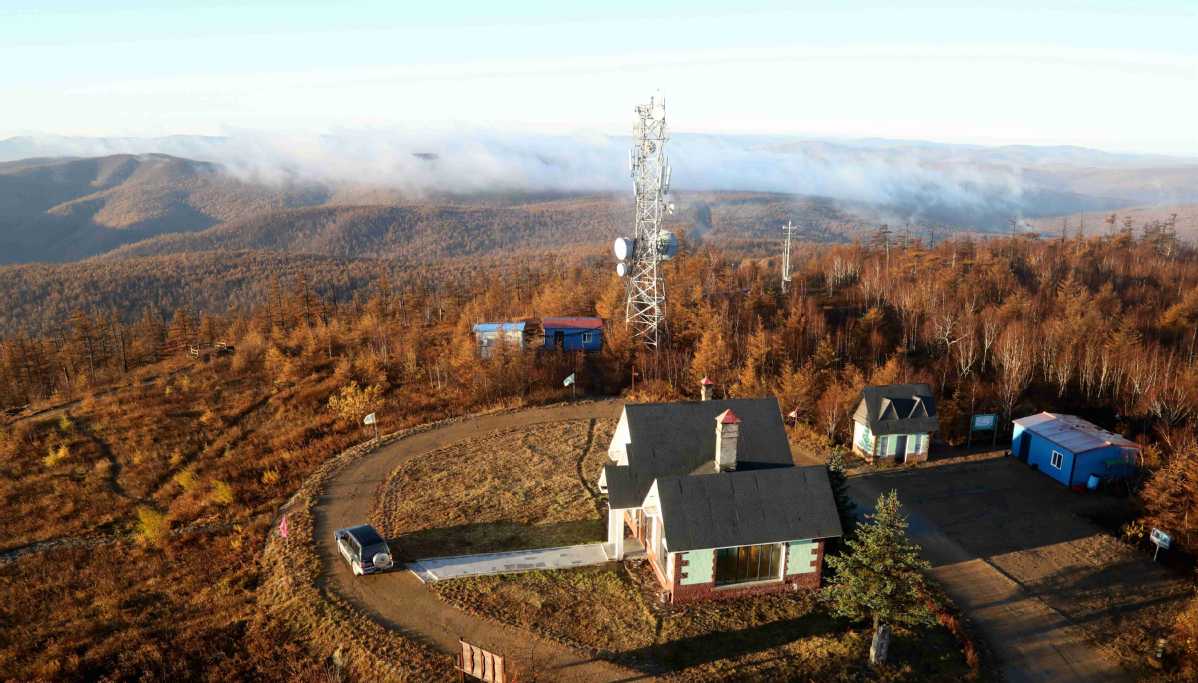China pushing to expand telecom services
An aerial view of a 4G base station in the Daxing'anling Mountains in the Inner Mongolia autonomous region. CHINA DAILY
Approach finding success in remote regions cut off by high mountains
China is making what is arguably the world's biggest push to reduce the digital divide between rural and urban residents, according to experts.
The country's mobile carriers and telecom tower builders are pouring tons of resources into ensuring that more people have access to fast, affordable mobile communications and broadband network services, officials said.
The move is part of broader efforts of the Ministry of Industry and Information Technology and the Ministry of Finance to promote inclusive telecom services.
The central government, local governments and telecom carriers have earmarked billions of dollars since the end of 2015 to overcome geographical barriers to expand network construction. That allows more people to benefit from upgraded internet services.
One focus is to expand the telecom signal coverage in the Daxing'anling Mountains in the Inner Mongolia autonomous region, officials said. The famous mountain range, located in the most northern area of China, is known as "nature's treasure trove."
Last year, the MIIT approved a plan to build 121 4G telecom base stations in the mountain range, and most of the construction work has already been completed.
After the project is completed, public network coverage is expected to increase from less than 10 percent to about 50 percent in the forest farms, scenic spots, fire watch towers, important roads and key fire danger areas in the mountains. Forest farming combines trees with crops or livestock.
E Liye, a forestry worker in the mountainous area, is one of the local people who have benefited from expanded telecom services.
From April to November, E and his colleagues went deep into the mountains to do field surveys. Starting this year, data collected by forestry workers does not have to be ferried back to technicians for analysis by motorcycle. Instead, it is transmitted in real time through the 4G network.
According to the MIIT, more will be done to increase coverage and support for key rural counties, border areas and key forest and grassland fire prevention areas as well as villages, forest farms, pastures and along major transportation routes. At the same time, the construction of 5G networks in rural areas will also be increased year by year.
Similar efforts are also being made in Yunnan province, changing the lives of people in remote areas. One of them, Xiong Yulan, 34, said she has childhood memories of the thundering explosions that once served to summon villagers for rallies.
In the early 1990s, gunpowder was the most efficient way to send messages in Xiong's hometown, the Dulongjiang township in Gongshan county, since no phones were available in that area, which is near the Derung River.
In 2019, Xiong and other residents started to see changes in the availability of 5G services as China Mobile, the nation's largest mobile telecom operator, set up a 5G station in the distant township.
Xiong said she was thrilled when she tried virtual reality glasses connected to the 5G network. She could see Kunming, Yunnan's provincial capital, about 900 kilometers away, in real time.
 |
Photos
Related Stories
- China's telecom sector registers stable growth in Jan-Oct
- China's telecom sector posts steady growth in Jan-Sept
- Inner Mongolia expands telecom networks in vast forests of Greater Hinggan Mountains
- China's telecom sector records stable expansion in January-May
- Saudi Telecom partners with Chinese tech firm Alibaba on cloud services
- China vows severe punishment for trans-border telecom fraud, 5 major cases under oversight
- China Telecom sees profits surge in 2021
- China Telecom expects profit surge in 2021
- Chinese firms to put on strong show at MWC 2022, indicating focus on European market
- China's telecom sector sees robust 2021 growth with better IT environment
Copyright © 2022 People's Daily Online. All Rights Reserved.










